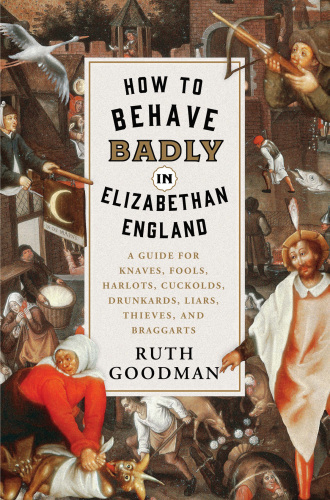
How to Behave Badly in Elizabethan England
A Guide for Knaves, Fools, Harlots, Cuckolds, Drunkards, Liars, Thieves, and Braggarts
کتاب های مرتبط
- اطلاعات
- نقد و بررسی
- دیدگاه کاربران
نقد و بررسی

July 1, 2018
With exhaustive research and in gleeful detail, Goodman (How to Be a Tudor, 2016, etc.) explores the gamut of misconduct in Stuart and Tudor England, including offensive speech and gestures, the perverse delights of mockery and ridicule, the ripostes of physical violence, and a gallery of repellent habits and repulsive displays of bodily functions.The author has a wicked taste for the objectionable and the wit to deliver it in a wholly enjoyable, even educational way. However, there is a more serious undertone to all of this impropriety, one that regards appropriate comportment and courtesy rituals as the lubrication of societal harmony. Likewise addressed are gender-based double standards (some of which still persist), the religious and public health basis of many of our behavioral prohibitions, dueling, expectations within hierarchies, power dynamics and, not least, British class consciousness. The book overflows with historical curiosities, interesting asides, and eyebrow-raising aha moments. Goodman also shows how one period's grave insult, verbal or gestural, was trifling to the next, even within the space of a generation or two. "Different behaviors shifted from good to bad and back again with disconcerting frequency," writes the author, requiring a chameleon's adaptability. Goodman's voice is tongue-in-cheek as often as scholarly, revealing how much of today's uncouth and loutish behavior has its antecedents in Elizabethan times. The book also is a primer for modern-day mischief-makers who can't resist thumbing their noses at the social mores of the "respectables." The author posits that bad behavior can be far more revealing of a time and culture than the exercise of rectitude, largely because history has reckoned with it far more eagerly. She demonstrates this truism with a wealth of amusing evidence. Still, it can be a bit much; even Miss Manners might tire of so much minutiae.Etiquette, it seems, is a complex and involved business, but Goodman helps us navigate the shoals of another era's sensibilities in a way that is also illuminating of our own.
COPYRIGHT(2018) Kirkus Reviews, ALL RIGHTS RESERVED.

Starred review from August 27, 2018
This entertaining, excellent book from Goodman (How to Be a Tudor) provides a window into the nitty-gritty of daily life for merchants, street sellers, and others listed in the subtitle in 1550–1660 England. Goodman writes conversationally about both pointedly bad behavior—for example clarifying in frank terms the meanings of insults based on body parts and functions—and contrasting attempts to keep up with trendy continental manners. She details the clothing and etiquette trends drifting in from Spain and France and the peculiarities wrought by the English Civil War and its effects on propriety. As in her previous work, Goodman’s scholarship is exemplary, and she sets the record straight on modern misperceptions of 16th- and 17th-century life; despite stereotypes to the contrary, for example, cleanliness and surprisingly precise meal etiquette were standard for most people. Illustrations depict such phenomena as complicated bows and fights between women in which the goal was to uncover each other’s hair—and imply the opponent was of loose moral character. Accessible, fun, and historically accurate, this etiquette guide will yield chuckles, surprises, and a greater understanding of everyday life in Renaissance England. Illus.

October 15, 2018
In previous books, Goodman (How To Be a Victorian; How To Be a Tudor) re-created Victorian and Tudor life as an immersive experience. Here, the author focuses her attention on the nonconforming members of the Elizabethan era. Arguing that one can discern more about a society from what was singled out as unacceptable, Goodman shows how many of the insults and conflicts of the time centered on reputation and honor, as a good name was currency in Elizabethan society. Covering issues such as physical violence, offensive speech, and impolite gestures, this latest work addresses the ways in which one could be set apart from society, either intentionally or unintentionally. While some sections can be a bit overly detailed, the work as a whole stands as an enlightening and entertaining read that defines the class structures of the period and the pitfalls to be avoided. VERDICT Similar to Daniel Pool's What Jane Austen Ate and Charles Dickens Knew, this work demonstrates Goodman's mastery of etiquette in 19th-century England. An informative social history for most readers.--Stacy Shaw, Denver
Copyright 2018 Library Journal, LLC Used with permission.

Starred review from September 15, 2018
If you're trying to understand the social rules of any culture, it helps to look for the places in which they start to break down. As history educator Goodman (How to Be a Tudor, 2016) points out at the start of a gleeful and illuminating journey through the behavioral underbelly of Tudor and early Stuart England (despite its title, the book covers the period through the aftermath of the English Civil War), "it is those who push against the boundaries of cultural etiquette who most accurately define where the lines are drawn." Her investigation of life along the boundaries of English Renaissance civility uncovers various categories of transgression, including insults, violent acts, and crude behavior, that are still recognizable today. Others, like flouting the precise rituals of bowing and hat management or abandoning one's inherited social position, will be more exotic to most readers and doubly fascinating. Goodman deftly combines anecdotes and examples that illustrate each topic and clear explanations of why certain behavior mattered socially and philosophically in that time and place. Both a highly readable and very funny treatment of a popular historical period and an invitation for readers to think about their own understandings of cultural etiquette.(Reprinted with permission of Booklist, copyright 2018, American Library Association.)

























دیدگاه کاربران